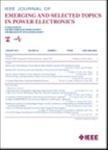版权所有:内蒙古大学图书馆 技术提供:维普资讯• 智图
内蒙古自治区呼和浩特市赛罕区大学西街235号 邮编: 010021

作者机构:Tech Univ Denmark Dept Elect Engn DK-2800 Lyngby Denmark
出 版 物:《IEEE JOURNAL OF EMERGING AND SELECTED TOPICS IN POWER ELECTRONICS》 (IEEE J. Emerg. Sel. Top. Power Electron.)
年 卷 期:2021年第9卷第5期
页 面:5838-5850页
核心收录:
基 金:European Union H2020 - Industrial Leadership Funding Source: H2020 - Industrial Leadership
主 题:Charge pumps Light emitting diodes Capacitors Switches Reactive power RLC circuits Switching frequency Charge pump LED drivers power factor correction (PFC) resonant power conversion zero-voltage switching (ZVS)
摘 要:This article presents the design and implementation of a resonant LED driver. The driver structure comprises a charge-pump-based power factor correction (PFC) converter and a class-DE dc-dc converter. The PFC converter uses a charge-pump circuit that achieves PFC inherently. The class-DE converter comprises a series-resonant tank and a high-frequency transformer. Both the converters share the same half-bridge and gate-driving circuit, resulting in an integrated-stage architecture. The inherent PFC operation limits the controller responsibility to the regulation of the output current. The overall converter operates with zero-voltage switching (ZVS) across the entire load range, allowing for increased switching frequencies with reduced switching losses. A 1-MHz prototype using wide bandgap (WBG) switching devices is built and tested. The prototype delivers up to 42 W of output power, with a power density of 1.8 W/cm(3). A power factor of 0.99 and a total harmonic distortion (THD) of 6% are achieved, with an efficiency of 90% at full load. The input current harmonic magnitudes are well within the IEC 61000-3-2 standard limits for class-C devices. Burst-mode (ON/OFF) modulation is used for output current regulation between 20 and 900 mA for dimming functionality.